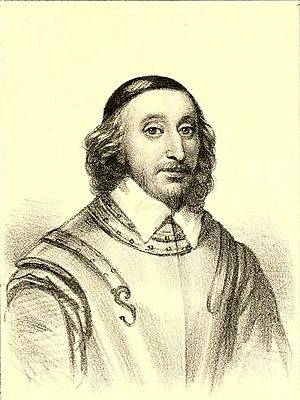Alexander Montgomerie, 6th Earl of Eglinton facts for kids
Quick facts for kids
Alexander Montgomerie, 6th Earl of Eglinton
|
|
|---|---|
 |
|
| 6th Earl of Eglinton | |
| In office 1612–1661 |
|
| Succeeded by | Hugh Montgomerie, 7th Earl of Eglinton |
| Personal details | |
| Born | 1588 |
| Died | 7 January 1661 |
| Spouses |
|
| Children | 8 |
| Parents |
|
| Military service | |
| Commands | Scottish regiment of horse |
| Battles/wars | Battle of Marston Moor |
Alexander Montgomerie, 6th Earl of Eglinton (born 1588 – died 7 January 1661) was an important Scottish noble and soldier. He was first known as Sir Alexander Seton of Foulstruther.
Contents
Becoming the Earl of Eglinton
Alexander was the third son of Robert Seton, 1st Earl of Winton. His mother was Lady Margaret Montgomerie. She was the daughter of Hugh Montgomerie, 3rd Earl of Eglinton.
In 1606, Alexander was involved in a small fight in Perth. He was with his older brother, the Master of Winton. They met the Earl of Glencairn and his group. The servants from both sides started fighting. This happened because of a very old family disagreement between the Eglinton and Glencairn families. The town guards quickly stopped the fight. Luckily, not many people were hurt.
In 1612, Alexander became the Earl of Eglinton. This happened after his cousin, Hugh Montgomerie, 5th Earl of Eglinton, passed away without children. His cousin had arranged for Alexander to inherit the title. But Alexander had to agree to take the name and family symbols of Montgomerie. King James VI officially approved this in 1615.
Alexander's wife, Anne Livingstone, had a powerful friend named Jean Drummond. Jean helped convince Anne of Denmark, the Queen, to speak to King James. This helped Alexander secure his new title.
A Leader in Scotland
Alexander Montgomerie was a strong leader. He spoke out against changes to the church in Scotland. These changes included using a new prayer book. He also helped prepare the National Covenant. This was an important document signed by many Scots. It promised to defend their religion.
In 1641, he became a Privy Councillor of Scotland. This meant he was a trusted advisor to the King.
The Soldier Known as Greysteel
Alexander was often called Greysteel. He was a brave soldier. He led a Scottish group of horse soldiers, also known as cavalry. These soldiers fought for the English Parliament. He showed great courage at the Battle of Marston Moor in 1644. This was a very big battle during the English Civil War.
After King Charles I was executed in 1649, Alexander supported bringing Charles II back to the throne. He also supported the plans of the Marquess of Argyll.
In 1651, Alexander was captured by Oliver Cromwell's forces. He was held in Edinburgh Castle. Later, he was allowed to move freely in Berwick. His family's lands were taken for two years. However, he was later included in a special act by Cromwell. This act allowed some people to get their lands back.
His Family Life
In 1612, Alexander married Anne Livingstone. She was the daughter of Alexander Livingstone, 1st Earl of Linlithgow. Anne had worked for Princess Elizabeth and Anne of Denmark.
Alexander and Anne had several children:
- Hugh Montgomerie (1613-1669), who later became the 7th Earl of Eglinton.
- Henry Montgomerie of Giffen.
- Colonel Alexander Montgomerie (born 1615).
- Colonel James Montgomerie of Coylsfield (died 1675).
- General Robert Montgomerie, who was injured at the Battle of Marston Moor.
- Margaret Montgomerie.
- Eleanor Montgomerie.
- Anna Montgomerie.
Alexander later married a second time to Margaret Scott. She was the daughter of Walter Scott, 1st Lord Scott of Buccleuch.
See Also

